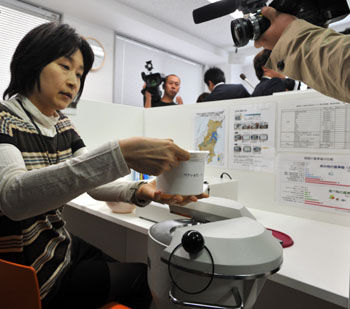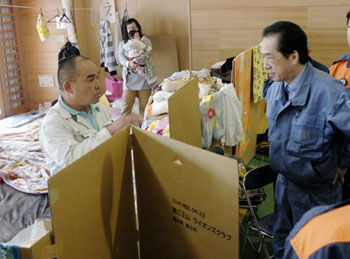
The tranquil residential city of 406,000 in Chiba Prefecture rarely enters the national spotlight, except when Kashiwa Reysol, the local soccer team, is playing at home.
But on a street just six minutes from JR Kashiwa Station, the Bec-Miru facility that Motohiro Takamatsu opened in October is turning heads by offering residents a chance to scan their own groceries, garden soil and other items for radiation.
"To have Kashiwa become contaminated with radiation, that was a big deal for me," the software engineer and accidental entrepreneur said in a recent interview with The Japan Times.
Takamatsu imported several LB 200 gamma spectroscopy machines from Germany to equip his new shop, which allows anyone to check items for contamination from the Fukushima nuclear crisis for a fee of ¥980 per 20 minutes.
The high-tech radiation detectors cost ¥1 million each but can detect cesium levels as low as 20 becquerels, as long as customers provide 1 kg of the item.
The machines have proven popular. People brought in 3,000 items to Bec-Miru for scanning in the first two months, and reservations are now common.
The surreal sight of a do-it-yourself radiation testing facility standing next to a hardware store and an Internet cafe raises a question for Japan: Is this the new normal?
The March 11 earthquake, tsunami and ensuing nuclear disaster set the unthinkable in motion in 2011. Teachers in Tohoku now carry Geiger counters to check radiation levels on school grounds, and cesium isotopes have shown up in baby formula, rice and tea.
Just by tainting the food chain, the disaster at the Fukushima No. 1 nuclear plant created a whole new generation of activists - whether or not they realized it at the time.
"Before March 11, I wasn't involved in any grassroots movement or any sort of antinuclear activity," said Takamatsu, who has two young children. "Now, I worry about the safety of food."
The end of the world as we knew it started with a 9.0-magnitude earthquake that struck at 2:46 p.m. on March 11, setting in motion a chain of events that resulted in the country's worst nuclear accident. The quake entered the record books as the fourth-largest temblor ever recorded.
Then came the tsunami - more than 16 meters high in some places - that obliterated the northeastern coastline.
It was months before the nation could grasp the enormity of the destruction and the immense death toll. As for Friday, more than 15,800 fatalities had been confirmed and over 3,400 people still remain missing, nine months after the twin disasters struck.
It was later learned that quakes of this magnitude hit the Tohoku area about once every 600 years, and seismologists pointed out that massive tsunami hit the northeast coast in 869 and could do so again.
As the tide receded, the public's first reaction was to ask whether the enormous death and destruction could have been avoided, or at least mitigated, if sufficient safety measures had been taken.

Ignoring the fact that approximately 10 percent of all the world's earthquakes take place on or near the Japanese archipelago was a fatal error, Ishibashi noted.
This situation unfortunately means there is no such thing as a single comprehensive measure for preparing for giant temblors, he said.
"Japan is the most dangerous place to construct a nuclear power plant," he said.
Still, Tokyo Electric Power Co., which built the Fukushima No. 1 plant based on flawed risk assessments and thus with inadequate safety measures, is sticking to its view that a killer wave of that scale could not have been predicted.
But 2011 was not only an extraordinary year on account of the Great East Japan Earthquake, it was also remarkable for the sheer number of temblors that were registered at level 5 on the Japanese seismic intensity scale, which tops out at 7.
As of mid-December, 68 such temblors had been recorded compared with just five in 2010, four in 2009 and eight in 2008, according to the Meteorological Agency.
If the relentless temblors and finger-pointing weren't enough to shake the public's confidence, the government's weak response to the nuclear crisis - which was widely perceived as lacking in leadership and effective countermeasures - sorely tested its limits.
It began with the government first denying that the Fukushima crisis was comparable to the Chernobyl disaster, only to acknowledge a month later that its severity was on a par with the 1986 accident in what is now Ukraine and deserved the highest ranking on the International Nuclear and Radiological Event Scale.
The assessment came more than a month after the meltdowns, highlighting Tokyo's inability to deal with the incident.
In July, the government's credibility took another blow when it was learned that beef containing more than 500 becquerels of cesium per kilogram had hit the market and been purchased by the public, before authorities became aware of the high radiation levels.
The contamination was later found to have occurred when cattle were fed straw tainted with radioactive fallout from the wrecked No. 1 plant, bolstering the perception that the government's response was deeply inadequate.
As of December, the government had yet to decide on new radiation guidelines for food, while safety standards for soil are also pending, forcing many local governments to stand idly by as highly contaminated sand continues to pile up.
One of the few things that did take place on schedule was the once-a-year resignation of a Japanese prime minister, a recent and dysfunctional political custom that was observed for the fifth straight year - this time in the midst of a nuclear safety crisis, no less.
"The government's confusion is intolerable," Liberal Democratic Party President Sadakazu Tanigaki said at a meeting the opposition party held in July.
"We've continued to seriously criticize the way (then) Prime Minister Naoto Kan is handling the issue, but I'm fed up," he declared.
That same month, ruling Democratic Party of Japan lawmaker Ryu Matsumoto was sacked as reconstruction minister after just a week in the job for making comments construed as insensitive during a visit to the devastated northeast.
Meanwhile, the cost of rebuilding Tohoku compelled the government to draft four supplementary budgets in the current fiscal year.
About ¥15 trillion has already been allocated for reconstruction projects, and another ¥3.8 trillion has been earmarked for use in fiscal 2012.
The government estimates that approximately ¥19 trillion will be required in the first five years to rebuild the shattered region.
As for "too big to fail" Tepco, the government in May agreed to provide taxpayer money to the utility so that it can compensate victims of the nuclear crisis. The payments are projected to total trillions of yen.
Tepco is expected to require additional injections of taxpayer funds because the cost of decommissioning the four damaged reactors at the Fukushima No. 1 plant is expected to amount to some ¥3 trillion.
The year was also notable for how the public's view of nuclear power shifted in light of the nuclear crisis, with many people slowly but steadily starting to question the government's energy policy and its heavy dependence on nuclear power.
Many acknowledged in surveys right after the accident that nuclear power is essential to Japan's energy needs, but some polls carried out later showed that 70 percent of the public wants the government to phase out nuclear energy.
The government's decision to shut down the Hamaoka nuclear power plant in May was supported by more than 65 percent of the public. The move was taken as a precaution, as the plant in Shizuoka Prefecture is considered highly prone to earthquakes.
Public sentiment is also strongly against restarting nuclear reactors currently under inspection. Only nine of the nation's 54 reactors were in operation as of Dec. 1, and all of them could potentially be offline by spring.
But how the nation will manage to meet its future energy needs if nuclear power is phased out remains unclear for now.
The year ended with Prime Minister Yoshihiko Noda announcing Dec. 16 that cold shutdown had been achieved at the three reactors that suffered meltdowns at the No. 1 plant, and declaring that the crisis had finally been brought under control.
But complete decommissioning of the reactors is expected to take at least 30 years, possibly even 40.
The nuclear catastrophe significantly bruised the nation's pride in 2011, and forced people to adapt to a world with scheduled electricity outages, food and water shortages, and limits on power use over the summer.
But while the government consistently disappointed the public and failed to show much leadership last year, people got back on their feet, dusted themselves off and came together to deal with the aftermath of the triple disasters.
Due to all the hardships in 2011, the word "kizuna" (human bonds) gained widespread currency, and was chosen by the Japanese Kanji Proficiency Society as the character that best described the year.
Volunteer workers both young and old headed to Tohoku to help out in any way they could, while aid workers from all over the world volunteered their services.
According to a survey of 10,000 Kanto area residents by Axa Life Insurance Co. in June, 85.4 percent of married people said their opinion of their partners improved after the incidents of March 11.
And while 46.4 percent of single people in a previous survey said they would not rush into marriage, that number fell to 40.8 percent after the quake, tsunami and nuclear disasters.
Perhaps the bonds formed in the aftermath will inspire more efforts like those of Bec-Miru owner Takamatsu in the new year.
Takamatsu said he has already established a new nonprofit organization aimed at creating a food safety database for consumers to access, and plans to expand it considerably in 2012.
"The database will focus on items that are not checked by the government, such as instant noodles," he said.
Despite losing more money than he is making on his Bec-Miru venture, Takamatsu said he is ready to spend another year doing whatever he can to help.
"These efforts are something I will continue as long as there is a need among the people."



Seems another meme of the times, and now reservations might be needed as well. Tsk, tsk, what would the ancestors say?